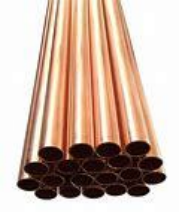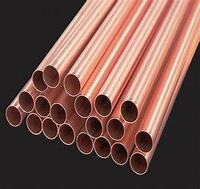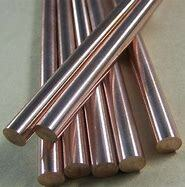1. Introduction
Copper rod is often associated with basic electrical wiring or plumbing, but its utility extends far beyond these common uses. In advanced engineering and industrial contexts, copper rod serves as a critical component in high-stakes applications where conductivity, corrosion resistance, and mechanical reliability are non-negotiable.

From grounding infrastructure in lightning-prone regions to precision joining in aerospace manufacturing, specialized forms of copper rod—including copper earth rod, copper brazing rod, and copper round bar—enable performance that generic materials cannot match. This article examines these niche applications, clarifying why specific copper rod variants are chosen and how they contribute to system integrity and efficiency.
2. Copper Rod in Advanced Earthing and Grounding Systems
One of the most critical yet underappreciated uses of copper rod is in earthing and grounding infrastructure. Facilities such as data centers, power substations, and telecom towers rely on robust grounding to protect equipment and personnel from electrical surges.
Pure copper earth rods offer excellent conductivity and longevity but come at a premium cost. As a cost-effective alternative, copper bonded earthing rods and copper clad steel ground rods combine a steel core for tensile strength with a copper coating for corrosion resistance and conductivity. These include copper bonded steel, copper clad earth rod, and copper clad steel earth rod variants.
Key specifications such as diameter and length (e.g., 16mm x 3m rods) are selected based on soil resistivity and required grounding resistance. The copper earth strip 25x3mm price is also a common consideration for horizontal grounding conductors, often used alongside vertical rods to form a complete grounding grid.
- Copper bonded ground rods reduce material costs while maintaining performance in moderate-corrosion environments.
- Pure rod copper is preferred in highly corrosive or high-conductivity-demand scenarios, despite higher copper rod price.
- Installation depth and soil enhancement (e.g., bentonite backfill) significantly affect earthing rod copper effectiveness.
3. Precision Joining: Copper Brazing and Welding Rods

In metal fabrication, especially for HVAC, refrigeration, and electrical bus systems, joining copper components demands materials that match the base metal’s thermal and electrical properties. This is where copper brazing rod and copper welding rod come into play.
Copper to copper brazing rods are formulated to flow smoothly at brazing temperatures without compromising joint integrity. They are essential for air conditioning copper pipe assemblies, where leaks can cause system failure. Similarly, copper rod for welding is used in specialized applications requiring high thermal conductivity post-weld.
Technicians often select copper to copper welding rod for repairs on busbars or transformer windings. Unlike steel-based welding rods, welding rod copper ensures minimal galvanic corrosion and maintains electrical continuity.
- Copper brazing rods typically contain phosphorus or silver alloys to lower melting points and improve wetting.
- Proper joint preparation and flux application are critical when using copper rod welding techniques.
- The best results in HVAC pipework come from using compatible copper pipe fittings with correctly sized copper tubing (e.g., 15mm copper pipe or 22mm copper tube).
4. Custom Electrical Components: From Round Bars to Flat Strips
Beyond rods and pipes, copper’s versatility shines in custom-fabricated components. Copper round bar and round bar copper are machined into connectors, terminals, and busbars. Flexible copper bus bar variants accommodate thermal expansion in high-current applications like switchgear and battery systems.

Flat forms—such as flat copper strip, beryllium copper strip, and nickel plated copper strip—are used in electronics, grounding straps, and EMI shielding. Thin copper strips (e.g., 1mm copper strip) serve in precision instruments, while copper strip roll formats enable efficient manufacturing.
Recycling and scrap operations also intersect with this niche: stripping copper wire for scrap requires methods like mechanical stripping (the best way to strip copper wire) rather than burning copper wire for scrap, which is environmentally hazardous and illegal in many regions.
- Copper strip for earthing is often specified in substation grounding mats.
- Copper roof strip and copper edging strip provide both aesthetic and functional corrosion resistance in architecture.
- Demand for copper strip near me drives local distribution of roll of copper strip and copper metal strips for small-scale fabricators.
5. Market and Material Considerations
Purchasing decisions hinge on performance needs versus budget. While pure copper rod offers superior performance, copper bonded and copper clad options provide viable compromises. The earthing rod price varies significantly between solid copper and copper bonded steel.
Similarly, copper pipe price and ac copper pipe price fluctuate with global copper markets, influencing choices in HVAC installations. For recyclers, the best way to strip copper cable impacts profitability—mechanical strippers offer a fast way to strip copper wire safely and legally.
Engineers and procurement specialists must also consider compatibility: mixing aluminum and copper (e.g., aluminum ground bar with copper wire) risks galvanic corrosion unless properly isolated.
6. Conclusion
Copper rod is far more than a commodity—it is a precision-engineered material enabling safety, efficiency, and innovation across advanced industrial domains. Whether deployed as a copper clad ground rod in a wind farm, a copper brazing rod in an aircon copper tube assembly, or a flexible copper bus bar in an EV battery pack, its role is both foundational and highly specialized.
Understanding the distinctions between copper rod types—alongside practical factors like copper rod price, installation method, and environmental conditions—ensures optimal performance and longevity in these critical applications.
Our Website founded on October 17, 2012, is a high-tech enterprise committed to the research and development, production, processing, sales and technical services of ceramic relative materials such as What. Our products includes but not limited to Boron Carbide Ceramic Products, Boron Nitride Ceramic Products, Silicon Carbide Ceramic Products, Silicon Nitride Ceramic Products, Zirconium Dioxide Ceramic Products, etc. If you are interested, please feel free to contact us.

